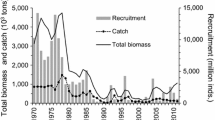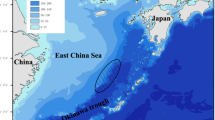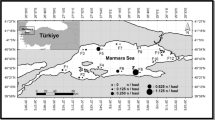Abstract
This work is devoted to the study of the abundance, distribution and growth performance of five Mugilidae species in three types of coastal habitats (coastal sea, estuaries and lagoon) located in a limited geographical area in the south-western Mediterranean (eastern coast of Algeria). The four sites considered (Caroube Beach, Mellah Lagoon, Boukhmira and Mafragh Estuaries) are differentiated by their salinity, which evolves at different intervals. The five species enter the considered paralic environments at very small sizes (2–3 cm TL). Regardless of site, Liza saliens is the most abundant (46.92%), followed by Liza aurata (23.72%), Chelon labrosus (13.96%), Liza ramada (11.80%) and Mugil cephalus (3.50%). Each species has a different occupation profile for each site (date of recruitment, relative abundance and demographic structure). The same is true for daily growth, which is better at Mafragh for L. saliens (0.7 ± 0.13 mm/day), at Boukhmira and Mafragh for L. aurata (0.53 ± 0.08 and 0.48 ± 0.09 mm/day, respectively), at Caroube for L. ramada (0.58 ± 0.12 mm/day) and at Mellah for C. labrosus (0.59 ± 0.14 mm/day) and M. cephalus (0.68 ± 0.17 mm/day). The closeness of the daily growth values for the five species to data obtained by various multi-year ageing methods (scalimetry, otolithometry) shows the validity of using otolith microstructures to determine the age of juvenile 0+ Mugilidae. This study shows heterogeneity in the relative abundance, demographic structure and somatic development of the five species considered depending on their habitat and suggests the influence of certain abiotic parameters on some of them. The two most interesting species for aquaculture (Liza ramada and M. cephalus) are relatively the least abundant, but still have interesting potential for freshwater aquaculture, because of their euryhalinity and their interesting maximum length, as well as their relatively fast growth in freshwater. The results of this study are of an applied nature because they contribute to the development of extensive mugilid aquaculture.







Similar content being viewed by others
Data Availability
All data generated or analysed during this study are included in this article.
References
Andaloro, F. 1983. Contribution to the knowledge of the age and growth of the Marsala lagoon golden mullet, Liza aurata (Risso, 1810). Report of the International Commission Mediterranean Sea 28 (5): 81–82.
Amara, R. 2003. Seasonal Ichthyodiversity and Growth Patterns of Juvenile Flatfish on a Nursery Ground in the Southern Bight of the North Sea (France). Environmental Biology of Fishes 67: 191–201.
Autem, M. 1979. Contribution à l’étude biologique des zones de dilution du littoral méditerranéen (estuaires et étangs lagunaires). I. Les estuaires languedociens et leurs poissons. II. Recherches sur les stratégies d’occupation de ces milieux par les poissons mugilidés. Différenciation, génétique, biologie. Thèse de Doctorat de 3ème cycle. USTL., Montpellier.
Avigliano, E., A.V. Volpedo, and B.D. Walther. 2020. Studying the biology of aquatic animals through calcified structures. Frontiers in Marine Science 7: 687.
Baptista, V., P. Morais, J. Cruz, S. Castanho, L. Ribeiro, P. Pousão-Ferreira, F. Leitão, Wolanski, and M.A. Teodósio. 2019. Swimming abilities of temperate pelagic fish larvae prove that they may control their dispersion in coastal areas. Diversity 11: 18
Battaglia, B. 1959. Final resolution of the symposium on the classification of brackish waters. Archo Oceanography Limnology 11: 243–248.
Becheker, A., L. Chaoui, and M.H. Kara. 2022. The profiles of occupancy by fish fauna of four shallow coastal habitats at a limited regional scale in the south-western Mediterranean. Regional Studies in Marine Science 51: 102195.
Belcari, P., A. Ligas, and C. Viva. 2006. Age determination and growth of juveniles of the European hake, Merluccius merluccius (L., 1758), in the northern Tyrrhenian Sea (NW Mediterranean). Fisheries Research 78 (2–3): 211–217.
Boubekeur, M.S., F. Derbal, M.S. Hannachi, and M.H. Kara. 2018. Structure of nearshore fish assemblages in Annaba coastal waters, Algeria (SW mediterranean sea). Vie Milieu - Life Environ. 68 (2–3): 87–97.
Brunelli, G. 1916. Ricerche sul novellame dei muggini, con osservazioni e considerazioni sulla mugginicoltura. Memoria R Comitato Talassografico Italiano 54: 45. https://doi.org/10.1201/b19927.
Bruslé, J., and M. Cambrony. 1992. Les lagunes méditerranéennes: des nurseries favorables aux juveniles de poisons euryhalins et/ou des pièges redoutables pour eux ? Analyse critique de la croissance des populations de muges de plusieurs étangs saumâtres du Languedoc-Roussillon, au cours de leur première année de vie. Vie milieu 42(2): 193–205.
Callicó Fortunato, R., V. Benedito Durà, and A. Volpedo. 2017a. Otolith morphometry and microchemistry as habitat markers for juvenile Mugil cephalus Linnaeus 1758 in nursery grounds in the Valencian community. Spain. Journal of Applied Ichthyology 33 (2): 163–167.
Callicó Fortunato, R., V. Benedito Durà, M. González-Castro, and A. Volpedo. 2017b. Morphological and morphometric changes of sagittae otoliths related to fish growth in three Mugilidae species. Journal of Applied Ichthyology 33 (6): 1137–1145.
Cambrony, M. 1983. Recrutement et biologie des stades juvéniles de mugilidés dans trois milieux lagunaires du Roussillon et du Narbonnais (Sases-Leucate, Lapalme, Bourdigou), Postgraduate thesis, University of Paris IV.
Campana, S.E., and J.D. Neilson. 1985. Microstructure of fish otoliths. Canadian Journal of Fisheries and Aquatic Sciences 42 (5): 1014–1032.
Cardona, L. 1999. Age and growth of lea** grey mullet (Liza saliens (Risso 1810)) in Minorca (Balearic Islands). Scientia Marina 63: 93–99.
Cardona, L. 2000. Effects of salinity on the habitat selection and growth performance of Mediterranean flathead grey mullet Mugil cephalus (Osteichthyes, Mugilidae). Estuarine, Coastal and Shelf Science 50 (5): 727–737.
Cardona, L. 2006. Habitat selection by grey mullets (Osteichthyes: Mugilidae) in Mediterranean estuaries: The role of salinity. Scientia Marina 70 (3): 443–455. https://doi.org/10.3989/scimar.2006.70n3443.
Cardona, L., B. Hereu, and X. Torras. 2008. Juvenile bottlenecks and salinity shape grey mullet assemblages in Mediterranean estuaries. Estuarine, Coastal and Shelf Science 77 (4): 623–632. https://doi.org/10.1016/j.ecss.2007.10.018.
Carpentieri, P., F. Colloca, and G.D. Ardizzone. 2005. Day night variations in the demersal nekton assemblage on the Mediterranean shelf-break. Estuarine, Coastal and Shelf Science 63: 577–588.
Chang, C.W., W.N. Tzeng, and Y.C. Lee. 2000. Recruitment and hatching dates of grey mullet (Mugil cephalus L.) juveniles in the Tanshui estuary of northwest Taiwan. Zoological Studies 39: 99–106.
Chauvet, C. 1986. Exploitation des poissons en milieu lagunaire méditerranéen. Dynamique du peuplement ichtyologique de la lagune de Tunis et des populations exploitées par des bordigues (muges, loups, daurades). Thèse de Doctorat d’Etat, Université de Perpignan, p 555.
Costanza, R., R. D’Arger, R. De Groot, S. Farber, M. Grasso, V. Hannon, K. Limburg, S. Naeem, R.V. O’Neill, J. Paruelo, R.G. Raskin, P. Sutton, and M. Van Der Belt. 1979. The value of the world’s ecosystem services and natural capital. Nature 287: 253–260.
Coutelan, R. 1953. Contribution a` l’étude des muges de l’étang de Thau. Montpellier: DES Université des Sciences et Techniques du Languedoc.
Crosetti, D. 2016. Current state of capture fisheries and culture of Mugilidae. In Biology, Ecology and Culture of Grey Mullets (Mugilidae), ed. S.J.M. Blaber, 398–450. Boca Raton, FL: CRC Press.
Embarek, R., R. Amara, and M.H. Kara. 2017. Fish assemblage structure in shallow waters of the Mellah lagoon (Algeria): Seasonal and spatial distribution patterns and relation to environmental parameters. Acta Ichthyol. Piscatoria 47 (2): 133–144. https://doi.org/10.3750/AIEP/02080.
Escalas, A., F. Ferraton, C. Paillon, G. Vidy, F. Carcaillet, C. Salen-Picard, F. Le Loc’h, P. Richard, and A.M. Darnaude. 2015. Spatial variations in dietary organic matter sources modulate the size and condition of fish juveniles in temperate lagoon nursery sites. Estuarine, Coastal and Shelf Science 152: 78–90
Ezzat, A. 1965. . Contribution à l’étude de la biologie de quelques mugilidés de la région de l’étang de Berre et de Port de Bouc. Thèse Univ. Aix Marseille, p 255.
FAO. 2022. La Situation mondiale des pêches et de l’aquaculture 2022. Vers une transformation bleue. Rome, FAO. https://doi.org/10.4060/cc0461fr
Farrugio, H. 1977. Clés commentées pour la détermination des adultes et des alevins de Mugilidae de Tunisie. Cybium 3(2): 57–73.
Fehri-Bedoui, R., and H. Gharbi. 2005. Age and growth of Liza aurata (Mugilidae) along Tunisian coasts. Cybium 29: 119–126.
Gandolfi, G., M. Pesaro, and P. Tongiorgi. 1981. Osservazioni sulla montata del pesce novello lungo le coste italiana. Quaderni Del Laboratorio Di Tecnologia Della Pesca 3: 215–232.
Guidetti, P. 2009. La fauna: I vertebrati. In: Biocostruzioni marine-Elementi di architettura naturale. Quaderni Habitat: no. 22. Relini G. (Ed.): 79–87.
Hannachi, M.S., F. Derbal, M.S. Boubekeur, and M.H. Kara (2014) Composition and nychthemeral variations of shallow water ichthyofauna in the Gulf of Annaba, Algeria. Cybium 38(4): 243–253.
Harrison, I.J. 2003. Chelon labrosus. In The freshwater fishes of Europe, vol. 8/1, ed. P.J. Miller, 17–24. Wiebelsheim: Aula-Verlag.
Heldt, H. 1948. Contribution à l’étude de la biologie des muges des lacs tunisiens. Bull. Stat. Océanogr. Salammbô 41: 1–35.
Isnard, E., J. Tournois, D.J. McKenzie, F. Ferraton, N. Bodin, C. Aliaume, A.M. Darnaude. 2015. Getting a good start in life? A comparative analysis of the quality of lagoons as juvenile habitats for Gilthead Seabream Sparus aurata in the Gulf of Lions. Estuaries and Coasts. https://doi.org/10.1007/s12237-014-9939-6
Jaafour, S., A. Yahyaoui, A. Sadak, M. Bacha, and R. Amara. 2015. Fish assemblages of a shallow Mediterranean lagoon (Nador, Morocco): An analysis based on species and functional guilds. Acta Ichthyologica Et Piscatoria 45 (2): 115–124. https://doi.org/10.3750/AIP2015.45.2.01.
Kara, M.H., and J.P. Quignard, eds. 2019. Fishes in lagoons and estuaries in the Mediterranean 3A: Migratory Fish, 159–256. John Wiley & Sons.
Karvounaris, D. 1963. Alcune osservazioni su Mugil chelo Cuv. nel lago di Paola. Bollettino Di Pesca, Piscicultura e Idrobiologia 18: 71–89.
Katselis, G., G. Minos, A. Marmagas, G. Hotos, and I. Ondrias. 1994. Seasonal distribution of Mugilidae fry and juveniles in Messolonghi coastal waters, western Greece. Bios (macedonia, Greece) 2: 101–108.
Khalil, M.T. 1997. Changes in the mullet fishery of Lake Manzala. Egypt. International Journal of Salt Lake Research 5: 241–251.
Lecomte-Finiger, R. 1999. L’otolithe: La “boîte noire” des Téléostéens. L’année Biologique 38 (2): 107–122.
Mariani, A., Panella, S., Monaco, G., Cataudella S. 1987. Size analysis of inorganic particles in the alimentary tracts of Mediterranean Mullet species suitable for aquaculture. Aquaculture 62 (2): 123–129.
Marin, E.B.J., A. Quintero, D. Bussiere, and J.J. Dodson. 2003. Reproduction and recruitment of white mullet (Mugil curema) to a tropical lagoon (Margarita Island, Venezuela) as revealed by otolith microstructure. Fishery Bulletin 101: 809–821.
McDonough, C.J., and C.A. Wenner. 2003. Growth, recruitment and abundance of juvenile striped mullet (Mugil cephalus) in south Carolina estuaries. Fishery Bulletin 101: 343–357.
Pannella, G. 1971. Fish otoliths: Daily growth layers and periodical patterns. Science 173 (4002): 1124–1127.
Rountree, R.A., and K.W. Able. 2007. Spatial and temporal habitat use patterns for salt marsh nekton: Implications for ecological functions. Aquatic Ecology. 41 (1): 25–45.
Spich, K and D.P. Fey. 2020. Consequences of differences among readers in age estimations of Baltic cod larvae and early juveniles for growth rate and hatch date analysis. Is more experience always better? Fisheries Research. 225: 105500. https://doi.org/10.1016/j.fishres.2020.105500
Sun, P., Q. Chen, C. Fu, W. Zhu, J. Li, C. Zhang, X. Wang, Y. Li, X. Li, Z. Zhang, C. Yang, and Y. Tian. 2020. Daily growth of young-of-the-year largehead hairtail (Trichiurus japonicus) in relation to environmental variables in the East China Sea. Journal of Marine Systems. 201: 103243.
Thomson, J.M. 1990. Mugilidae. In Check-list of the fishes of the eastern tropical Atlantic, vol. II, ed. J.C. Quero, J.C. Hureau, C.A. Post, and L. Saldanha, 857–858. Paris, France: UNESCO.
Trape, S., J.D. Durand, L. Vigliola, and J. Panfili. 2017. Recruitment success and growth variability of mugilids in a West African estuary impacted by climate change. Estuarine, Coastal and Shelf Science. 198: 53–62.
Tzeng, W.N., and S.Y. Yu. 1988. Daily growth increments in otoliths of milkfish, Chanos chanos (Forsskal), larvae. Journal of Fish Biology 32: 495–504
Verdiell-Cubedo, D., F.J. Oliva-Paterna, A. Egea-Serrano, and M. Torralva. 2008. Population biology and habitat associations of benthic fish species in the shallow areas of a Mediterranean coastal lagoon (SE Iberian Peninsula). Scientia Marina. 72: 319–328.
Vidy, G., and J. Franc. 1992. Saisons de présence à la côte des alevins de muges (Mugilidae) en Tunisie. Cybium 16 (1): 53–71.
Villani, P. 1988. The absence of Mugilidae fry in a coastal lagoon of the southern Adriatic. FAO Fisheries Report 394: 381–388.
Volpedo, A.V., and A.M.Vaz-dos-Santos. 2015. Métodos de estudios con otolitos: principios y aplicaciones/ Métodos de estudos com otólitos: princípios e aplicações – 1a ed. edición bilingue. – Ciudad Autónoma de Buenos Aires.
Acknowledgements
The authors thank the Algerian Ministry for Higher Education and Scientific Research (General Directorate for Scientific Research and Technology Development, GDRSDT) which financially supported this study within the framework of the National Funds of Research (NFR, Contract N°3/2020—University of Annaba/DGRSDT). We thank Dr. Kelig Mahe (Ifremer, Manche-North Sea Fisheries Unit, Boulogne-sur-Mer, France) for welcoming and introducing Mr. Becheker Ali to the technique of reading the daily age from otoliths.
Funding
DGRSDT, 03/2020, Hichem M. KARA.
Author information
Authors and Affiliations
Corresponding author
Additional information
Communicated by Rachel Kelley Gittman
Supplementary Information
Below is the link to the electronic supplementary material.
Rights and permissions
Springer Nature or its licensor (e.g. a society or other partner) holds exclusive rights to this article under a publishing agreement with the author(s) or other rightsholder(s); author self-archiving of the accepted manuscript version of this article is solely governed by the terms of such publishing agreement and applicable law.
About this article
Cite this article
Becheker, A., Chaoui, L. & Kara, M.H. Habitat-Dependent Variation in the Relative Abundance and Growth of the YOY of Five Species of Mugilids in the South-Western Mediterranean. Estuaries and Coasts 47, 1315–1329 (2024). https://doi.org/10.1007/s12237-024-01356-5
Received:
Revised:
Accepted:
Published:
Issue Date:
DOI: https://doi.org/10.1007/s12237-024-01356-5




